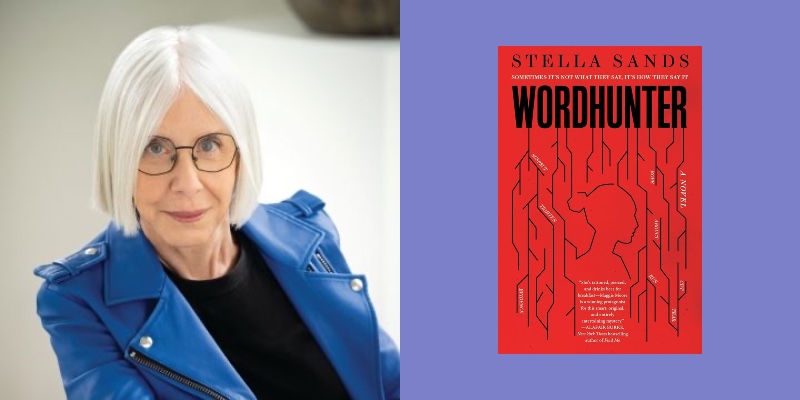In her first adult novel, Wordhunter, true crime maven Stella Sands brings readers an unusual and unique character: Maggie Moore, a brilliant basket case who happens to be a linguistic savant. Not a common crime fiction protagonist, Maggie was initially conceived as “a morbidly obese woman who never left her bedroom. She solved crimes using her brains and computer.” But over time, Sands says, “as I spent more and more time with her, she began to morph into someone totally different: a tattooed, pierced, motor-cycle riding, chain-smoking, Mezcal-drinking, Moon Pie-eating, foul-mouthed speaking, obsessive-compulsive badass.”
(“I credit this turn-around with having befriended my alter ego,” Sands notes cheekily.)
Maggie, 21 years old, and indeed a misfit, is a grad student studying forensic linguistics in a podunk college, Rosedale, in a Florida backwater. She’s haunted by the disappearance of Lucy, her childhood best friend, when they were seven years old, and generally a rather troubled soul. Except she’s a genius when it comes to all things language and that includes a love – an obsessive love – of such linguistic exercises as diagraming sentences, like this, Marlon Brando from the film, On the Waterfront:

Her favorite course is The Language of Film, taught by Professor Ditmire, a legendary film critic and author whom Maggie also finds attractive. After class one day he asks Maggie to come to his office, because he’s been contacted by the local police chief who watched a documentary about the Unabomber and how he was ultimately identified by word analysis with the help of family members. A cyber-stalker is terrorizing a young woman and the chief has dispatched a cop named Silas Jackson, “to follow up at Rosedale, hoping someone here might do the same.”
Ditmire praises Maggie’s academic work and she dazzles him with her knowledge of the Unabomber investigation and the linguistic minutiae involved in his capture. Interested, he asks? “Hell yeah!” Maggie exclaims. The professor also asks Maggie to be his research assistant. For Maggie, heaven must be like this.
She meets Jackson, who is, to put it mildly, a taciturn fellow – not exactly a match for the mental loquaciousness of Maggie’s interior life, not to mention her outward one. A mismatched pair, but as time goes on, they manage to work on the case together.
Sands is at once a playful writer and a serious one deeply engaged with the nuance(s) of language. Her breadth of knowledge of her clearly beloved subject – the power of words – is impressive. The novel is filled with diagrammed sentences – Maggie compulsively does them in her head, and we learn that even literary giant Gertrude Stein was a diagrammer. She is quoted as saying, “I really do not know that anything has ever been more exciting than diagramming sentences.”

***
Sands got her start writing true crime in a very untypical way. She explains what happened.
“When my daughter was young, we would go to Central Park… where dozens of kids would play in what we called “our backyard.” When the group got to be around five years old, they all dispersed and went to different schools for kindergarten, so the park didn’t serve as a daily retreat any longer. Fast forward 11 years from then, I read that one Daphne Abdela was accused of gutting a man in Central Park. I wondered: Could that be the same two-year-old Daphne who played [there]?
And? “Turned out, it was. I became obsessed. How could a sweet little toddler who lived on our block turn into a vicious killer? After months of thinking about it, I sent off a summary of a book I hoped to write about the murder, along with a first chapter to five true-crime agents, whose names I found on the Internet. Within a few days, I got four yesses. I chose one agent. That was how Baby-Faced Butchers came about and how my true crime writing began.”
Why did an accomplished true crime author write a novel?
“Writing fiction is a delightful way to spend time—when the writing itself is not torturous. I love my characters. I mean, really, really love them. I’d rather spend time with them than with most people I know. I love to figure out what they’ll do next. Will Maggie walk into a restaurant and yell: Fuck y’all or will she sidle up to a single guy and grab his dick. Anything’s possible in fiction.” (Well, when you put it that way…absolutely.)
You set the story in Florida. It’s actually quite appropriate because Florida is in many ways as wacked out of a place as Maggie is a person!
“Well, I was born there and have spent a lot of time there. I love the place. I’m endlessly fascinated by the diversity of its people, geography, animal life, and almost every other aspect of life there. From the wealthiest of the wealthy on the glitzy coasts to the dirt-poorest-of-the poor tomato pickers in the interior; from the subtropical pine forests to the marshes and swamps; from potentially deadly red ants, Eastern diamondback rattlesnakes and black widow spiders to friendly, curious manatees and one of the oldest species on the planet, the gopher tortoise… Florida’s got it all. And I haven’t even mentioned the ocean!”
And why a linguist as heroine?
“I am fascinated by how words work in a sentence, how they can communicate precisely exactly what we intend if one is careful with word choice, diction, and syntax.
“I am also fascinated with the order of the words in a sentence. How starting with, say, an adverbial clause instead of a subject can alter the entire meaning, rhythm, and emphasis of a sentence: Nuance, in other words. (Whether or not you like it, you’re going to the library. vs: You’re going to the library whether or not you like it. The former is stronger, beginning with the admonition.)
“On a more academic level, linguistics is an entry into phonetics, syntax, semantics, and the like. These aspects give us the know-how to communicate effectively.”
Okay, let’s look at the whole concept of sentence diagramming. Honestly, isn’t this simply an archaic teaching method by now? You and I both studied it in the seventh grade. And that was, for me at least, well, quite a while ago!
“I fell in love with diagramming in middle school when my teacher challenged us to make these “weird” visual diagrams of sentences. As I wrote in Wordhunter, Maggie’s teacher said, “You will go nowhere, be no one if you can’t take sentences apart and put them back together again.” My Ms. Barker told us kids the same thing. And since I wanted to be someone and go somewhere…. As it turned out, I was good at SD…”
Yes, but what do we learn by diagramming sentences?
“Basically, we learn how a sentence is constructed and how each word in a sentence relates to every other word. SD is a visual representation of that arrangement. A language picture, as it were. As Willie Loman’s wife Linda said, “Attention must be paid,” and that is definitely the case in diagramming. Each word, each and every single word, has its specific place on a diagram.”
Did your background in true crime inform your crime fiction writing?
“Writing true crime for a decade gave me some insight into the mind, motives, and methods of killers/serial killers. I also knew what not to have my fictional bad guys do—mostly because of the mistakes the real-life guys made. I incorporated many of the details from the bad guy’s psyche and methods into my crime fiction.”
After six true crime books, you decided to give it up. You note several difficult – heartbreaking, in fact – incidents in your life that caused you to make this decision. Can you elaborate what happened?
“While I was writing my sixth true crime book, my only sister died unexpectedly. Several months before that, my husband had passed away. And in the two years before that, both my mother and father had died. I had been feeling that I needed a change before my sister’s death, but that event sealed the deal. I could no longer dwell both in my writing life and in personal everyday social life in such utter darkness.”
Yes, being submerged in such sordid actions of deranged people has got to be very trying.
“True crime is tough to write, for me anyway, because I become involved in the victims’ families’ lives. I listen to their stories about their loved ones. I become their friends, and their heartache is heart-breaking.”
One aspect of Mindhunter I was happy to discover (and I don’t think it will act as a spoiler) is that you did not tie up some significant loose ends at the conclusion of the story…is there a sequel in the works?
“Yup. I’m already deep into it. I can’t let Maggie go yet. She’s my best buddy.”
She may well prove to be the same to your readers, Stella – your love of language and all its beauty, oddball rules, and vocal warts is most infectious, and of course, Maggie is simply an unforgettable character.

















